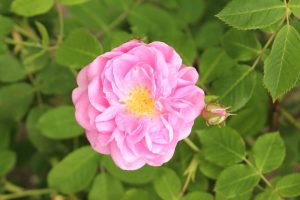How and Why to Plan & Create a Medicinal Herb Garden
By Dafydd Monks, BSc (Hons). Medical Herbalist
Many of us have a few culinary herbs growing in our gardens, but would you like to grow 14 really useful herbs in a small space and learn how to use them for your own health, beauty and well-being?
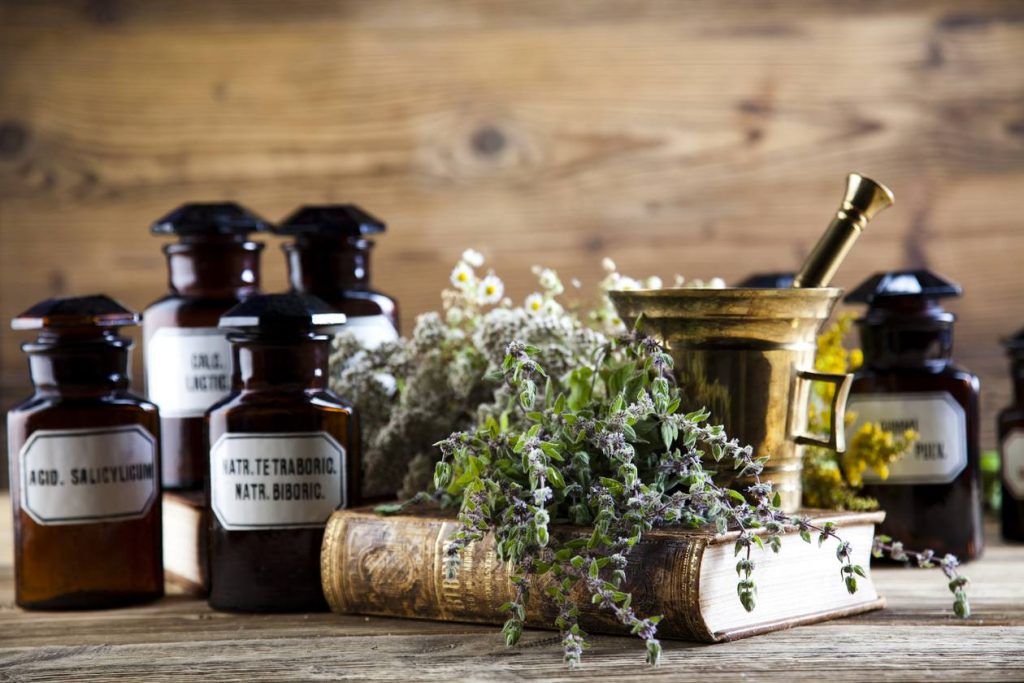
Man has used medicines made from herbs and other plants for millennia. Traditionally in England the lady of the house would have kept the family medicine chest, and it would have been her responsibility to keep it stocked with medicinal plants she would have grown.
Then as a wave of exploration exploded from Western Europe in the 1600s interesting and rare plants were collected and cultivated in ‘Physic Gardens’ – large gardens used by apothecaries and botanists.
Latterly, some of our most widely used pharmaceutical drugs have been derived from such collected medicinal plants; quinine from Chinchona, a plant from South America is an example of a rare plant introduced in the time of the Physic gardens and later developed into a drug.
As gardeners and growers, the link we have with medicinal plants and preparing medicines was always strong, and should rightly be strong again. Many herbalists were appreciable gardeners and botanists, and many gardeners and botanists would have been involved in the cultivation of medicines right up to the early 20th Century. So how can we start to re-root that connection? Planting your own herb bed or herb garden is a great way of getting involved, and broadening your horticultural horizons.
Grow Medicinal, Culinary and Cosmetic Herbs in a Small Space
When it comes to cultivating your own herbs, A 3 x 3 yard herb bed will be enough to give you a comprehensive herb bed for family use. With this space, you will be able to grow 15 – 20 different medicinal, culinary and cosmetic herbs; most of which also look nice and will brighten up your garden no end.
They will also add interest to your garden (herbs are always a good conversation starter!), give a steady supply of cut flowers for the home, attract bees and other beneficial pollinators, and preserve the medicinal (or ‘officinal’) strains of some more widely hybridised plants such as roses.
Of course, you may not have 3 x 3 yards of space spare if you have a smaller garden or small allotment. That’s fine – read this article and get a feel for what you’d like to plant, and select what you have space for and plant it anyway.
If you have an allotment, why not share this article with other allotment holders and have a communal herb bed, or share some of your herbs with others?
I’ve created a simple plan of a garden that fits within a 3 x 3 yard square and gives a balanced selection of herbs and medicinal plants for family use. I suggest making it in 3D, by either making a mound of soil giving you gently sloping sides, or having a large pot in the middle, with smaller pots around that, then down to soil at the edges of the bed. This maximises space and light.
Medicinal Herb Garden Plan
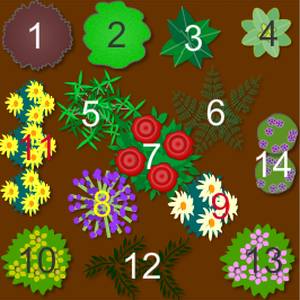 Medicinal Herbs
Medicinal Herbs
- Purple Sage
- Melissa
- Peppermint
- Thyme
- Rosemary
- Fennel
- Damask Rose
- Englisher Lavender
- Feverfew
- St, John’s Wort
- Pot Marigolds
- Yarrow
- Echinacea
- Heartsease
Damask Rose
The centrepiece of this bed is a Damask Rose. This is one of the three commonly used medicinal roses, and has lovely pink-red petals and most importantly a lovely aromatic scent.
There are many damask roses, and the original hybrid is probably lost to us, however most medicines and perfumes are made with the Kazanlak variety, which is grown extensively in Bulgaria in ‘the rose capital of Europe’. This particular variety is very vigorous and sturdy while being lovely in the garden and when used in flower arrangements, crafts, etc. It also has many medicinal uses.
Next come four larger plants, positioned around the central rose. You can plant them in pots if you like, or plant them on the level: they’re taller than the outer edge of plants, so they will still give a pleasing pyramidal shape to your herb bed.
Rosemary
We’ll start with Rosemary. This culinary herb will be familiar to many but did you know that as well as hugely improving the taste of meat and stews, Rosemary also calms the digestion and improves the flow of blood to the brain? When I was at university, I remember the exam room stinking of rosemary tea from all the herbal students taking in litre bottles of the stuff.
Fennel
Fennel is the ultimate digestif herb. It dispels flatulence, calms gripes, soothes those with an overproduction of stomach acid, and also helps those who experience stomach upsets as a result of stress. Chewing Fennel seeds also freshens breath!
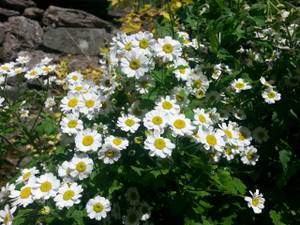
Feverfew (Tanacetum Parthenium)
Feverfew
Feverfew is a familiar sight to many gardeners as it often grows as a weed. It really should be encouraged though as it is an excellent treatment for migraines. Long term use is effective in preventing migraines.
English Lavender
A herb that is very good for inducing sleep or relaxation is lavender. The flowers are highly scented and used in such diverse ways as lavender sugar, where it adds a slightly scented aroma, through to a tea made from the dried flowers, which is quite bitter and stimulating to the digestion.
Lavender is most known for its relaxing qualities though. A small bunch of flowers hung in the shower or under the hot tap of the bath is particularly calming and soothing before bed.
Peppermint
Next, we’ll plant herbs around the outside of the bed. Starting with Peppermint, another familiar culinary herb. This herb is lovely with lamb dishes. It is also a key ingredient in ‘winter ills’ tea, along with Yarrow and Elderflower.
Thyme
Thyme is a small plant and can be ‘popped in’ to corners of your herb bed or where you have space between bigger plants, although it does like good exposure to sunlight, so avoid shading it too much.
Thyme aids digestion, like many culinary herbs, hence it’s use in food. It is however so much more, being highly antifungal and antibacterial. You can use an infusion of Thyme as a mouthwash, a disinfectant for wounds, and as a wash for mild fungal skin infections.
Sage
The natural companion to Thyme, both gastronomically and medicinally is Sage. Sage has similar properties to Thyme, but complements and extends them. It is antispasmodic, relaxing muscle tissue. Herbalists use Sage in cases of asthma or panic attacks for this purpose. It is also a liver tonic due to its bitterness. Sage dries up catarrh and reduces night sweating.
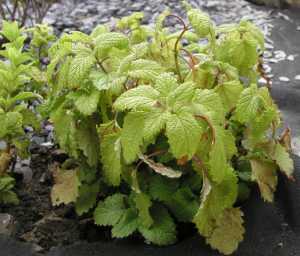
Lemon Balm
Melissa or Lemon B alm
Melissa or Lemon Balm is best taken as a tea brewed from the fresh leaves. It is calming to the mood and emotions and is relaxing while not being overly sedative. It has a lovely aroma and can be incorporated into ‘herb pillows’ to aid sleep.
St John’s Wort
St John’s Wort has received a lot of attention as an antidepressant, but it is also really very useful as an antiviral herb and as a wound healer. The fresh flowers are infused in olive oil on a sunlit windowsill which makes a lovely deep red oil suitable for applying to cuts and burns.
Pot Marigolds
Pot marigolds are very useful for clearing the skin. A face wash can be made by brewing the flower heads into a tea and washing your face in the resulting liquid. They also soothe and tone mucus membranes. An example of this is using the brewed liquid as a rinse for ulcers, etc.
Yarrow
Yarrow is a grassland loving ‘weed’. It will grow happily in a bed, and if you don’t like the white flowers of the native strain, the American strain of yarrow (they’re both Achillea millefolium) has pinkish red flowers and behaves in the same was as its European cousin medicinally.
Yarrow is a great winter herb alongside peppermint and elderflower, equal parts of which make an excellent ‘winter ills’ tea.

Echinacea (Echinacea purpurea)
Echinacea
Echinacea is a well-known herbal medicine; it has become very popular as an immune tonic. It has a rather lovely pink-purple daisy like flower which would be suited to any herb bed or cottage garden. All parts of the plant are medicinally active.
Heartsease
Lastly we come to Heartsease. This is another ‘skin herb’ that is often used alongside marigolds to treat eczema, as it clears the skin and is mildly anti-allergenic. It is also used in rheumatic conditions.
If this article aims to do one thing, it’s to whet your appetite to have a go at growing a few herbs and to learn a bit about what they do. If you can only grow one or two herbs in your allotment or garden, that’s still better than none.
Of course this is just the barest of starts, the rest is up to you. So plant your herb garden, read up on the many uses herbs will have in your life, and inspire yourself to start using your herbs, creating your own ‘family medicine chest’ using your new found knowledge and interest!
Further Information on Medicinal Herbs
Snowdonia Botanical Medicine My website, with other articles, news and events I organise across North Wales. I welcome relevant and constructive comments or questions and can be contacted via my web site.
Herb Seed and Plant Suppliers
Further Reading
Grow Your Own Drugs: Fantastically Easy Recipes for Natural Remedies and Beauty Treats
James Wong. Collins, 2009
Herbcraft Naturally, Christina Stapley. Heartsease Books, 1994
Herbwise Naturally, Christina Stapley. Heartsease Books, 2000
The Herb Garden (New ed.), Sarah Garland. Frances Lincoln, 2003

